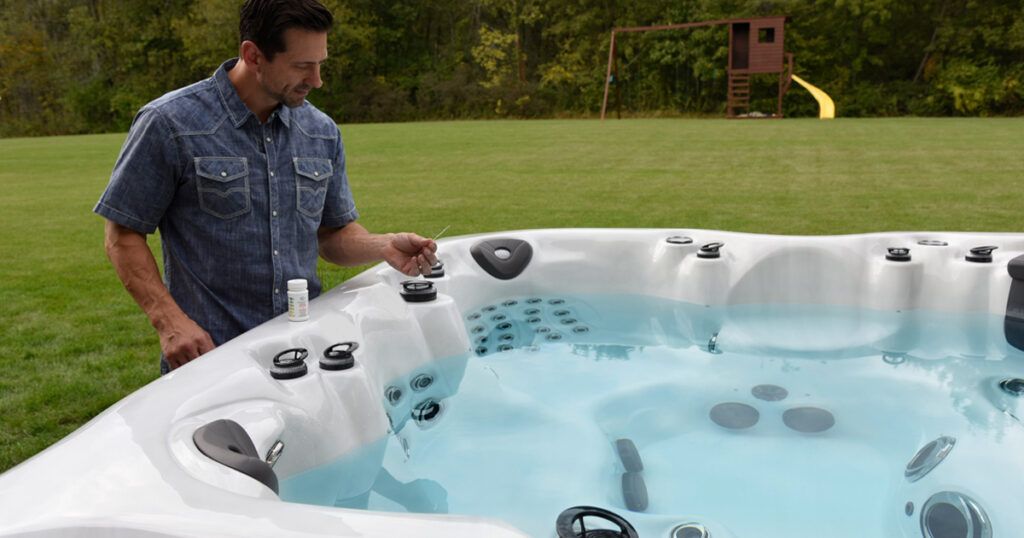Having the proper alkalinity level in your hot tub water is extremely important for keeping the water in balance and preventing damage to the hot tub. If the alkalinity gets too low, it can cause a variety of issues.
Page Contents
What is Alkalinity?
Alkalinity refers to the ability of the water to resist changes in pH. It is a measure of the total levels of carbonates, bicarbonates, hydroxides, and other alkaline substances dissolved in the water. The recommended alkalinity level for hot tubs is typically between 80-120 ppm (parts per million).
Causes of Low Alkalinity
There are a few potential causes of low alkalinity in hot tubs:
- Not adding enough alkalinity increaser when refilling the tub
- Neglecting to check and adjust alkalinity levels regularly
- Using unbalanced refill water with low alkalinity
- Dilution from repeated draining/refilling without adding alkalinity increaser
- Overuse of pH reducers
Effects of Low Alkalinity
Having low alkalinity can negatively impact your hot tub in the following ways:
Difficulty Maintaining Proper pH
With low alkalinity, the pH level can easily swing outside of the ideal range of 7.2-7.8. Small additions of chemicals or bather load changes have a greater impact on pH when the buffering capacity of the water is low.
Corrosion Damage
Without sufficient alkalinity, the water can become highly corrosive. This corrodes metal components and etched/damaged acrylic surfaces in the hot tub.
Cloudy Water
Low alkalinity can make it difficult to maintain proper calcium hardness and pH levels. This allows water to become unstable, leading to cloudiness issues.
Skin/Eye Irritation
Bathing in water with unbalanced pH and low alkalinity can irritate eyes, skin, and mucous membranes.
Foaming
Low alkalinity often causes the water to foam or suds excessively, even without soap present.
Shortened Filter Cycles
The filtration system may not be able to efficiently remove contaminants and maintain water clarity with low alkalinity levels.
Reduced Disinfectant Efficacy
Sanitizers like chlorine work optimally within the proper pH range. Low alkalinity throws off pH and may decrease their germ-killing ability.
Staining
Low alkalinity can lead to metallic staining on surfaces from metals leaching into the water.
Fixing Low Alkalinity
In order to raise alkalinity levels in your hot tub, you will need to add an alkalinity increaser chemical. Follow these steps:
- Test current alkalinity level using test strips.
- Determine how much to raise the level based on test results (aim for 80-120 ppm).
- Add the appropriate amount of alkalinity increaser per manufacturer instructions.
- Run jets on high speed with cover off for 30 minutes to mix thoroughly.
- Retest alkalinity after 24 hours and make adjustments until target level is reached.
Popular alkalinity increaser choices include sodium hydrogen carbonate, sodium carbonate, and sodium bicarbonate. Add small amounts at a time, retest, and repeat as needed to slowly bring the level back up. Drastic alkalinity spikes can be just as problematic as low levels.
Preventing Low Alkalinity
Once your alkalinity is restored, you can take these steps to avoid becoming too low again:
- Test alkalinity weekly and adjust as needed.
- Add alkalinity increaser after draining/refilling tub.
- Use a water testing kit before refill to ensure water source has sufficient alkalinity.
- Limit draining/refilling to only when necessary.
- Rinse off bathers before soaking to reduce chemical usage.
- Shock tub regularly to oxidize contaminants.
Ideal Alkalinity Levels
Here is a quick overview of the ideal alkalinity levels for hot tubs:
| Alkalinity Level | Status |
|---|---|
| Less than 60 ppm | Dangerously Low |
| 60-80 ppm | Too Low |
| 80-120 ppm | Ideal Range |
| 120-180 ppm | OK, but not ideal |
| Over 180 ppm | Too High |
Testing Alkalinity
Testing alkalinity in your hot tub regularly is the only way to catch low levels before major issues occur. Here are some testing tips:
- Use an accurate test kit to measure alkalinity.
- Test 1-2 times per week minimum.
- Test alkalinity 30 minutes after dosing chemicals.
- Compare test results to ideal range and adjust as needed.
- Store test kits out of sunlight and extreme temperatures.
- Replace test kit reagents every 3-6 months.
- Take water samples from 18-24 inches below waterline.
- Rinse sample cells thoroughly between tests.
Conclusion
Low alkalinity is a common hot tub water balance issue that can lead to damage and soaking discomfort if left unchecked. Test alkalinity regularly and use an alkalinity increaser as needed to maintain levels between 80-120 ppm. This will help buffer the pH, prevent corrosion and cloudiness, and lead to clean, soothing spa water.
Implementing a consistent hot tub water care routine with regular sanitization, filtration, and testing will help prevent major alkalinity fluctuations. Your hot tub can provide years of relaxing soaks with proper maintenance and water balance.
